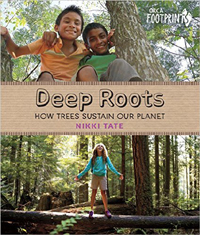| ________________
CM . . .
. Volume XXII Number 26. . . .March 11, 2016

 |
Deep Roots: How Trees Sustain Our Planet. (Orca Footprints).
Nikki Tate.
Victoria, BC: Orca, 2016.
48 pp., hc., pdf & epub, $19.95 (hc.).
ISBN 978-1-4598-0582-8 (pbk.), ISBN 978-1-4598-0583-5 (pdf), ISBN 978-1-4598-0584-2 (epub).
Subject Headings:
Trees-Juvenile literature.
Trees-Ecology-Juvenile literature.
Grades 5-8 / Ages 10-13.
Review by Sophia Hunter.
**** /4
Reviewed from Advance Reading Copy.
|
| |
|

excerpt:
What is a carbon sink?
Anything that is able to absorb CO2 and keep it out of the atmosphere is called a carbon sink. Trees and forests are excellent carbon sinks, sucking up and storing huge amounts of CO2. This CO2 is released when the forests burn or when trees fall slowly and rot. Planting trees is a good way to help reduce the effects of excessive CO2 production. Unfortunately, rapid deforestation (for fuel and building materials, and to clear land for agriculture and housing) is making it difficult to plant enough tress to replace those that have been cut down.
Deep Roots is a welcome addition to the “Orca Footprints” timely and well-conceived series of books on environmental issues for middle school readers. In keeping with other books in the series, this title includes lots of enticing full-colour photographs, great use of headings and fact boxes, and relevant global information.
The book is divided into four chapters: Earth, Air, Water and Fire. The author takes a broad view, looking at how trees affect our everyday life, and the long-term implications of pollution, deforestation, and climate change. The role of trees around the world is considered, for both humans, other animals and plants.
The layout is clearly organized with today’s internet-savvy reader in mind. The pages are colourful, employ ample margins and intriguing fact boxes. One fact box series, entitled “I [Heart-using the symbol, not the word] Trees”, is unnecessary. It mostly includes anecdotal stories from the author, expanding on her daily interactions with and memories of trees. They are not particularly compelling. The “Try This!” fact box is better conceived, presenting readers with ways to enjoy trees in their community and better understand the role they play in a healthy local ecosystem.
As with other books in this series, there are print and web resources listed at the back for further research. There is also a comprehensive glossary. The table of contents is detailed, but section headings are a bit abstract. The index should help clear up any confusion.
Tate does a wonderful job of creating a broad, but succinct, overview of trees and the critical role they play in our life. She includes examples from around the world, not forgetting urban dwellers. As many libraries and classrooms are seeking to provide more information to young readers on climate change and environmental issues, Deep Roots will be a wonderful addition.
Highly Recommended.
Sophia Hunter is a teacher-librarian at Crofton House School in Vancouver, BC.

To comment
on this title or this review, send mail to cm@umanitoba.ca.
Copyright © the Manitoba Library Association. Reproduction for personal
use is permitted only if this copyright notice is maintained. Any
other reproduction is prohibited without permission.
Next Review | Table of Contents For This Issue - March 26, 2016
CM Home | Back Issues
| Search
| CM Archive
| Profiles Archive
|
